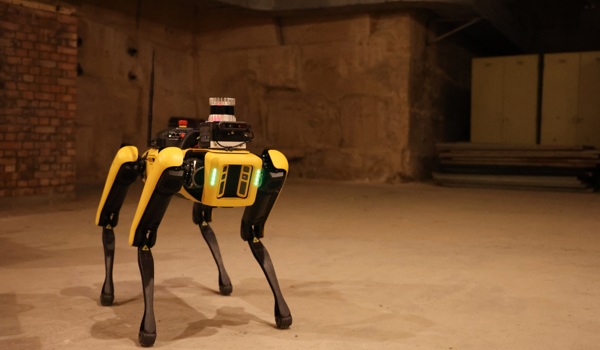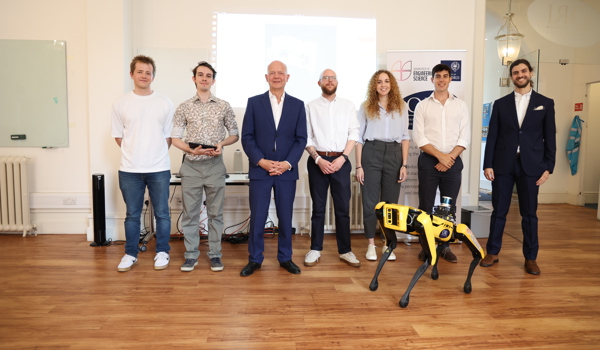11 Nov 2022
Oxford quadruped robot research tested on a live Chevron facility
Dynamic Locomotion and Autonomous Inspection trialed in Ghent, Belgium
Robots doing inspection and remote monitoring has the potential to increase efficiency on energy sites. They can also help lower carbon emissions and reduce risks to personnel.
In Spring 2022, researchers from Oxford Robotics Institute demonstrated their legged robot research on a live Chevron petrochemical facility in Ghent, Belgium. The team demonstrated control algorithms (developed by University of Oxford) enabling the ANYbotics ANYmal quadruped robot to cross loose debrib and climb gravel slopes. The Boston Dynamics Spot robot was tasked with autonomously inspection - capturing images of pressure gauges, thermal hot spots as well as a general visual inspection.
The trial marked the culmination of the 4-year Offshore Robotics for Certification of Assets Hub (ORCA) which developed robotics for inspection and maintenance in the energy sector. ORCA is a consortium of universities led by Heriot Watt University, funded by the EPSRC and Industry Strategy Challenge Fund (ISCF). The specific trial was made possible by funding from the Net Zero Technology Centre (NZTC) which supports innovation aimed at reducing carbon emissions in the energy sector.
Why Quadruped Robots?
The trials demonstrated quadruped robot capability in operational facilities, a key step in developing awareness and trust in robots as they are adopted by the energy industry. Quadruped robots offer unique benefits over non-legged inspection robots. Unlike wheeled or tracked robots, their advanced manoeuvrability provides a robotic solution that can autonomously navigate through cluttered and ever changing industrial facilities and climb stairs without causing any damage.
Live Trial with Two Robots
Chevron offered a typical industrial site for the deployment of the robots, including potential hazards and hurdles such as metal gratings, stairs, rubble and ongoing activities in the live facility.
The ANYbotics ANYmal C robot was used to test the capabilities of a quadrupedal robot control framework that was developed by Oxford called RLOC. This reinforcement learning-based robot controller learned to walk using example experiences generated in a physically-realistic computer simulator which was then transferred to the real robot for testing without re-tuning. Testing on the ANYmal C robot involved traversing areas of concrete, tarmac, gravel, slopes, surfaces typical to outdoor industrial facilities. In addition, the ANYmal used its inspection payload to zoom in and take pictures of analog and digital dials, as well as thermal images of thermal vents, throughout the facility.
The Boston Dynamics Spot part of the trial focused on autonomous inspection - testing our AutoInspect autonomy solution. First the robot was led around the facility to build a 3D map containing a “mission graph” of the points of interest: the pressure and temperature gauges and points of interest mentioned above. The team devised a mission to visit these inspection points while travelling across the facility - including climbing industrial stairs and capturing sensor measurements and pictures. To test the robustness of the system, Chevron tasked the team with repeating trials. The same identical trial of 15 minutes operation was repeated 10 times with 8 successes and just 2 being operator-terminated (due to a cautious safety check).
Autonomous rerouting was also demonstrated: where a route on the graph was blocked ORI’s autonomy system needed to plan a different mission to complete the inspection.

Three different shots of the same valve during the repeased experiments. The autonomy system is so repeatable that only the change in the background shadows shows that the time has elapsed.
Impact of the Trial
This trial provided field validation of the potential for the future use of legged robots in remote operator tasks in hazardous facilities. It allows Chevron to focus its R&D activity towards the issues which will enable these robots to be deployed in longer term trials.
Initial results from the trial and Chevron’s broader engagement with ORCA was recently presented at the industry-leaning SPRINT Robotics Conference in September in Amsterdam. At the conclusion of the project a full report on the learnings from the trial will be made available to industry by NZTC.
Broadly speaking the trial will play a role in building user trust in the deployment of quadruped robots in their intended environment, aiding robotic adoption within Chevron itself and by wider industry.
Future Development
Robotics developers at University of Oxford will use the trial to build on the autonomous capabilities of quadruped robots for hazardous area inspection, better preparing them for live operational deployment. Following the successful pilot, ORI has gone on to deploy these systems on nuclear facilities (in Sellafield, Cumbria) and also on a Costain construction site at Gatwick Airport Train Station.
Lessons learned from the Chevron trial will be shared with the wider energy community to encourage the use of quadruped robots as an inspection method for industrial sites.
Oxford’s team was led by Prof. Maurice Fallon and Prof. Ioannis Havoutis as well as Michal Staniaszek and Dr. Wolfgang Merkt. Further contributions came from Dr. Siddhant Gangapurwala, Benoit Casseau and Prof. Nicholas Hawes.
Find out more details about the AutoInspect autonomy solution here.

The ANYmal and Spot robots on-site at Chevron's Ghent facility



